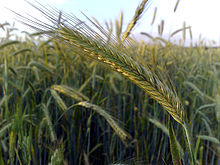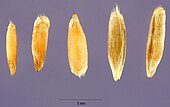Rye
|
|
This article needs additional citations for verification. (February 2012) |
| Rye | |
|---|---|
 |
|
| Scientific classification | |
| Kingdom: | Plantae |
| (unranked): | Angiosperms |
| (unranked): | Monocotyledons |
| (unranked): | Commelinids |
| Order: | Poales |
| Family: | Poaceae |
| Subfamily: | Pooideae |
| Tribe: | Triticeae |
| Genus: | Secale |
| Species: | S. cereale |
| Binomial name | |
| Secale cereale L. |
|
| Synonyms | |
|
Secale fragile M.Bieb. |
|
Rye (Secale cereale) is a grass grown extensively as a grain and as a forage crop. It is a member of the wheat tribe (Triticeae) and is closely related to barley (Hordeum) and wheat (Triticum). Rye grain is used for flour, rye bread, rye beer, some whiskeys, some vodkas, and animal fodder. It can also be eaten whole, either as boiled rye berries, or by being rolled, similar to rolled oats.
Rye is a cereal grain and should not be confused with ryegrass, which is used for lawns, pasture, and hay for livestock.
Contents |
[edit] History
Rye is one of a number of species that grow wild in central and eastern Turkey, and adjacent areas. Domesticated rye occurs in small quantities at a number of Neolithic sites in Turkey, such as PPNB Can Hasan III, but is otherwise virtually absent from the archaeological record until the Bronze Age of central Europe, c. 1800-1500 BC.[1] It is possible that rye traveled west from Turkey as a minor admixture in wheat (possibly as a result of Vavilovian mimicry), and was only later cultivated in its own right. Although archeological evidence of this grain has been found in Roman contexts along the Rhine, Danube, and in the British Isles,[citation needed] Pliny the Elder was dismissive of rye, writing that it "is a very poor food and only serves to avert starvation" and spelt is mixed into it "to mitigate its bitter taste, and even then is most unpleasant to the stomach" (N.H. 18.40).[original research?]
Since the Middle Ages, rye has been widely cultivated in Central and Eastern Europe, and is the main bread cereal in most areas east of the French-German border and north of Hungary. In Southern Europe, it was cultivated on marginal lands.
Claims of much earlier cultivation of rye, at the Epipalaeolithic site of Tell Abu Hureyra in the Euphrates valley of northern Syria, remain controversial. Critics point to inconsistencies in the radiocarbon dates, and identifications based solely on grain, rather than on chaff.
[edit] Agronomy
Winter rye is any breed of rye planted in the fall to provide ground cover for the winter. It actually grows during any warmer days of the winter, when sunlight temporarily brings the plant to above freezing, even while there is still general snow cover. It can be used to prevent the growth of winter-hardy weeds, and can either be harvested as a bonus crop, or tilled directly into the ground in spring to provide more organic matter for the next summer's crop. It is sometimes used in winter gardens, and is a very common nurse crop.
The flame moth, rustic shoulder-knot and turnip moth are among the species of Lepidoptera whose larvae feed on rye.
[edit] Production and consumption statistics
| Top Ten Rye Producers — 2005 (million metric ton) |
|
|---|---|
| 3.6 | |
| 3.4 | |
| 2.8 | |
| 1.2 | |
| 1.1 | |
| 0.6 | |
| 0.4 | |
| 0.3 | |
| 0.2 | |
| 0.2 | |
| World Total | 13.3 |
| EU 2008 figures include Poland, Germany and Austria. |
|
| Source: FAO [2] | |
| Minerals | ||
|---|---|---|
| Ca | 33 mg | |
| Fe | 2.67 mg | |
| Mn | 121 mg | |
| P | 374 mg | |
| K | 264 mg | |
| Na | 6 mg | |
| Zn | 3.73 mg | |
| Cu | 0.450 mg | |
| Mg | 2.680 mg | |
| Se | 0.035 mg | |
Rye is grown primarily in Eastern, Central and Northern Europe. The main rye belt stretches from northern Germany through Poland, Ukraine, Belarus, Lithuania and Latvia into central and northern Russia. Rye is also grown in North America (Canada and the USA), in South America (Argentina, Brazil), in Turkey, in Kazakstan and in northern China.
Production levels of rye are falling in most of the producing nations. For instance, production of rye in Russia fell from 13.9 million tons in 1992 to just 3.4 Mt in 2005. Corresponding figures for other countries are as follows: Poland - 5.9 Mt in 1992 and 3.4 Mt in 2005; Germany - 3.3 Mt & 2.8 Mt; Belarus - 3.1 Mt & 1.2 Mt; China - 1.7 Mt & 0.6 Mt; Kazakhstan - 0.6 Mt & 0.02 Mt.
Most rye is consumed locally, and is exported only to neighboring countries, but not worldwide.
[edit] Diseases
Rye is highly susceptible to the ergot fungus. Consumption of ergot-infected rye by humans and animals results in a serious medical condition known as ergotism. Ergotism can cause both physical and mental harm, including convulsions, miscarriage, necrosis of digits, hallucinations and death. Historically, damp northern countries that have depended on rye as a staple crop were subject to periodic epidemics of this condition. There have been "occurrence[s] of ergotism with periods where there were high incidents of people persecuted for being witches. Emphasis was placed on the Salem witch trials in Massachusetts in 1692, where there was a sudden rise in the number of people accused of being witches, but earlier examples were taken from Europe, as well."[3]
|
||||||||||||||||||||
[edit] Uses
Rye bread, including pumpernickel, is a widely eaten food in Northern and Eastern Europe. Rye is also used to make crisp bread. Rye flour is high in gliadin but low in glutenin. It therefore has a lower gluten content than wheat flour. It also contains a higher proportion of soluble fiber. Alkylresorcinols are phenolic lipids present in high amounts in the bran layer (e.g. pericarp, testa and aleurone layers) of wheat and rye (0.1-0.3 % of dry weight).[4]
Other uses of rye include rye whiskey, kvass and an alternative medicine known as rye extract. Rye straw is used to make corn dollies.
[edit] Cultivation
Rye grows well in much poorer soils than those necessary for most cereal grains. Thus, it is an especially valuable crop in regions where the soil has sand or peat. Rye plants withstand cold better than other small grains do. Rye will survive with snow cover that would otherwise result in winter-kill for winter wheat. Most farmers grow winter ryes, which are planted and begin to grow in autumn. In spring, the plants develop and produce their crop.[3] Fall planted rye shows fast growth. By late June plants reach their maximum height, of about four feet (102 cm) while spring planted wheat has only recently germinated. Vigorous growth suppresses even the most noxious weed competitors, and rye can be grown without application of herbicides.
[edit] References
- ^ Daniel Zohary and Maria Hopf, Domestication of plants in the Old World, third edition (Oxford: University Press, 2000), p. 75
- ^ "Major Food And Agricultural Commodities And Producers - Countries By Commodity". Fao.org. http://www.fao.org/es/ess/top/commodity.html?lang=en&item=71&year=2005. Retrieved 2010-09-17.
- ^ a b George J. Wong (1951-08-12). "Ergot of Rye: History". Botany.hawaii.edu. http://www.botany.hawaii.edu/faculty/wong/BOT135/LECT12.HTM. Retrieved 2010-09-17.
- ^ Structures of 5-alkylresorcinol-related analogues in rye. Yoshikatsu Suzuki, , Yasuaki Esumi, Isamu Yamaguchi, Phytochemistry, Volume 52, Issue 2, September 1999, Pages 281–289, doi:10.1016/S0031-9422(99)00196-X
[edit] Further reading
- Rolf Schlegel (2006). "Rye (Secale cereale L.) - a younger crop plant with bright future". In R. J. Sing and P. Jauhar. Genetic Resources, Chromosome Engineering, and Crop Improvement: Vol. II Cereals. CRC Press, Boca Raton. pp. 365–394. ISBN 0-8493-1430-5.
- Gordon Hillman (July 2001). "New evidence of Lateglacial cereal cultivation at Abu Hureyra on the Euphrates". The Holocene vol. 11 no. 4: p. 383–393. http://hol.sagepub.com/content/11/4/383.abstract.
[edit] External links
| Wikimedia Commons has media related to: Secale cereale |
- Rolf Schlegel: Rye cytogenetics and breeding (Secale cereale L.)"Rye cytogenetics". Rolf Schlegel. http://www.plant-breeding.privat.t-online.de/Rye_cytogenetics/rye_cytogenetics.html. Retrieved 2011-02-01.
- Rolf Schlegel: Genes, markers, and linkage data of rye (Secale cereale L.)"Rye gene map". Rolf Schlegel. http://www.rye-gene-map.de. Retrieved 2010-09-17.
- Rolf Schlegel: Current List of Wheats with Rye and Alien "Rye introgression". Rolf Schlegel. http://www.rye-gene-map.de/rye-introgression. Retrieved 2010-09-17.
- Rolf Schlegel: Plant breeding updates "Plant Breeding Updates". Rolf Schlegel. http://www.plant-breeding-update.de. Retrieved 2010-09-17.
- Growing Rye hosted by the UNT Government Documents Department
- "Secale cereale". Integrated Taxonomic Information System. http://www.itis.gov/servlet/SingleRpt/SingleRpt?search_topic=TSN&search_value=42089. Retrieved September 22, 2002.
- Multilingual taxonomic information from the University of Melbourne
|
|||||



